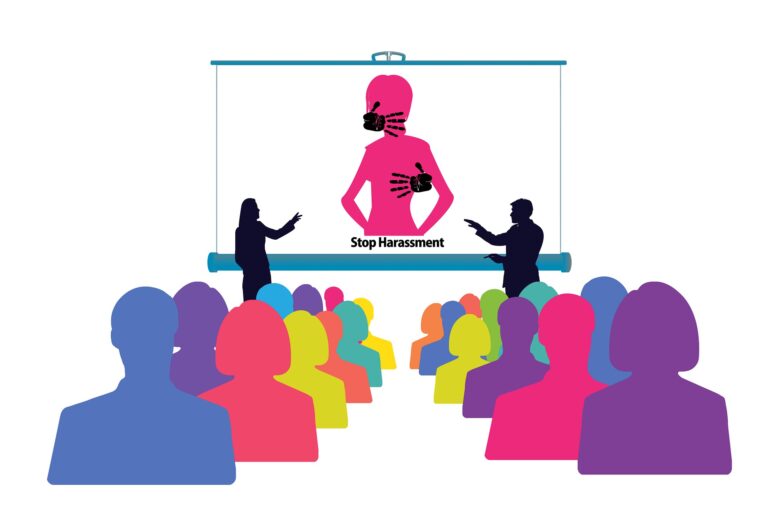January 2025
Contents
- Blue Tulip Consultancy – Welcome
- Conscious Inclusion
- Case Law – Dismissal of autistic employee justified
- Good Stories
With our training and consultancy support the primary focus is on
- Proactive and Preventative Actions to Sexual Harassment
- Understanding and controlling Microaggressions
- Organising and Managing Reciprocal Mentoring
- Finding Your Mojo – Professional Leadership Development Programme for Ethnic Minority Groups
- Inclusive Leadership Coaching – one-to-one or group coaching
Happy New Year!
I spent a month in Goa, India and returned last weekend. Whilst there, I went to a few Iyengar yoga classes, a form of yoga that I had not experienced previously. As a novice, I noted that the yoga teacher, his assistants and other class members were incredibly supportive in guiding me doing the poses correctly. Although I did struggle during the sessions, some of the poses were hard, I would always leave each class with my head held high, I felt looked after.
This was an epitome moment of inclusive practice; the representation of caring behaviours and the feel good impact.
Conscious Inclusion
In my interactions with a number of organisations, I am noticing that managers and leaders are making references to the concept of Conscious Inclusion. I have pondered on the use of this term, is this a revamped, trendier version of unconscious bias? There is a difference between the two. Unconscious biases can lead to overt and subtle unintentional discrimination or usually negative perceptions about an individual or groups. These biases are shaped by personal experiences, societal norms, and cultural influences. Conscious inclusion, in its ideal state, refers to an active effort to create an environment where all individuals feel valued, respected, and included.
I do have reservations about the idea of Conscious Inclusion as a considered approach to inclusivity as it seems to imply that colleagues are being put under pressure to conform to a certain standard of enforced behaviour ( eg: stop saying this, don’t be biased) and that they have to be deliberate and (painstakingly) conscientious in being inclusive. This in turn may trigger resistance, defiance, even other expressions of discomfort against being inclusive irrespective of its benefits and alignment to the organisation’s moral compass and ethical practices.
I have been providing training and consultancy support to a bank over a few years. It has a base in UK, though its head office is in Europe. The participants are from all over Europe and further afield. The sessions are interactive, engaging, and respectful. Participants are able to share their reflections, ask questions and seek clarification. Whilst I am not aware that the participants (from senior leaders to junior staff) have been asked to be deliberately ‘consciously inclusive’, the behaviour of respect is embedded as part of the organisation’s ethos and values.
Conscious Inclusion is about ensuring that everyone, irrespective of their background is provided with equal opportunities to thrive. The focus is more on inclusive behaviours and practices rather than simply addressing the avoidance of biases. A considered move from passive awareness to proactive inclusion. This sounds effective in theory but how is it managed in practice? In the ever changing arena of inclusive practices, I advocate against the seductive nature of using buzz words to sound good, it is about proactively creating an environment that has good, evidence-based measures of effective practices.
I provided coaching to a senior member of staff in a charity, she talked at length and with pain, how although some of managers regularly talked about the value of conscious inclusion, professing egalitarian values, in reality, the same managers would interrupt her frequently, were dismissive towards her and took credit of her ideas and contributions. She tried to manage these behaviours but was labelled as being too sensitive and paranoid. In effect not only was she excluded, but she was also ‘gas lit’ for raising concerns about her experiences. It became a double-edged biased interaction, the behaviour towards her, possibly because she is a woman and in the minority with perhaps the need to maintain affinity bias amongst the men.
There is value to creating a culture of inclusivity through two processes, both which are action oriented as opposed to concept led. The first process is threefold: Reflect, a considered critique of own biases and prejudices with the question ‘would I engage differently if the person was of a different race, gender, status etc?’, Speak Out, a willingness to stand up for fairness. Being proactive in correcting systems to create a more inclusive organisation. In response to the last process, some organisations are asking managers to focus on a diversity and inclusion related objective, to effect change, as part of their appraisals.The second process is about creating a culture of micro-inclusions and micro-affirmations, thereby promoting inclusive behaviours:
- Evaluating Team Dynamics. Observing and taking note of who is talking, who is being listened to, how is work allocated, who is acknowledged and supported in their growth and development. Engaging with the team to understand how everyone is included and how they would want to be included. How are the reflectors/introverts supported? What language patterns are used to describe people, acknowledging the experiences of being in the minority to being part of the majority.
- Creating a safe space to give and receive feedback specifically in relation to inclusive practices, managing expectations/opportunities and sharing vulnerability.
- Sharing ideas and experiences of struggles. Tips and suggestions are offered and shared. A team ethos is created to enable for everyone is to contribute, chime in and make suggestions.
- Invite contributions from junior and/or colleagues who are engaging via remote means. Acknowledge contributions and manage interruptions. Highlight contributions and acts of kindness. Create a culture where each member is able to share their contribution to the team’s progress and recognise another team member’s contribution. (note this will need to be done with sensitivity with clear guidelines)
There is value to moving away from the blaming, shaming, and naming culture and understanding that implementing new trends simply for the sake of it, is no longer considered effective. The focus of being inclusive is to create an environment of action based micro-inclusions and micro affirmations. Harvard Business Review in their research article ‘The Power of Small Acts of Inclusion’ highlighted that micro-inclusions boost a sense of trust and belonging. There were also reports of an increase in employees’ commitment to the organisation and an increase in self confidence in doing the job well. By focusing on the positive and building on strengths does create an inclusive culture without the need to be conscious or deliberate.
Interesting Case Law

Dismissal of autistic employee justified after she sent a series of abusive emails to colleaguesInteresting
In Kaler v Insights ESC Limited, the Employment Appeal Tribunal (EAT) was asked to rule on whether a teacher who had been dismissed for sending numerous abusive emails to her colleagues, had been subjected to discrimination arising from her disability, namely autism.
The Claimant, K, worked for a school that instructed children with social, emotional, behavioural, and mental health needs. When K was first engaged by the school as a supply teacher in March 2013, she shared with the school’s Principal that she was “going through the process of being diagnosed” with Asperger’s syndrome and that she considered herself to be disabled.
K left the school in June 2013, following a disagreement with a colleague, and did not start working for the school again until January 2017. She was open about her autism and described herself as an ‘aspie.’
In January 2018, K was dismissed for gross misconduct after sending a substantial number of abusive, threatening, and harassing emails to colleagues. The emails concerned issues regarding her salary. Some of the emails were sent to all staff members, and she refused to stop the barrage even after she was told to do so. She also sent sexually inappropriate texts to a colleague.
Following her dismissal, K brought the following claims in the Employment Tribunal:
- direct disability discrimination,
- discrimination for reasons arising from a disability, and
- failure to make reasonable adjustments. The Employment Appeals Tribunal (EAT) disagreed with the Tribunal’s finding that the Principal could not be expected to remember an email from three and a half years ago from an employee stating they believed they had autism. The reference K made to being an “aspie” in her most recent employment was enough to put the Principal on notice regarding K’s possible disability.
K argued that her autism left her prone to having “meltdowns.” The Employment Tribunal first had to decide whether the Principal knew or ought to have known about K’s disability (referred to as Constructive Knowledge). It held that it was unreasonable to expect the Principal to remember K’s comment made in 2013, namely that she was “going through the process of being diagnosed” with Asperger’s syndrome. K’s reference to being an ‘aspie’ was also not enough to establish Constructive Knowledge.
The EAT disagreed, stating that the evidence presented by K regarding her 2013 comments and referring to herself as an ‘aspie’ were enough to put the Principal “on notice” that K had a disability. However, the EAT upheld the Tribunal’s finding that, regardless of any disability, K’s conduct was so bad and serious that dismissing her was both justified and proportional.
Source: Bowcock and Pursaill Solicitors January 2025

Good Stories
Diversity, equity and inclusion (DEI) within firms is linked with either positive or neutral firm performance outcomes, according to new LSE research.
Teresa Almeida and Dr Grace Lordan found that DEI is positively associated with long-term market valuation and innovation, suggesting that DEI initiatives can be of strategic importance for organisations. Furthermore, DEI appears to be unrelated to short-term financial metrics such as stock returns and profitability, indicating that DEI improvements do not come at the expense of short-term financial performance.
Overall, the researchers find that their DEI proxy is associated with stronger long-term market performance, but not short-term market performance. Larger effects are found for growth firms. Furthermore, the study highlights that the positive effects of DEI on long-term market performance are amplified in firms with higher levels of ethnic diversity in senior management.
Dr Lordan, Director of The Inclusion Initiative at LSE, said: “We are essentially measuring the aspects of culture that relate to DEI using data external to the firm. Doing so, our work has uncovered a credible signal that predicts innovation and long run market performance that should interest investors. Our proxy is particularly strong for firms that are in their growth phase. Forthcoming work will demonstrate these links using a portfolio selection approach. For me this is good news for firms that have invested in DEI in an authentic way amidst a DEI backlash.
Ms Almeida, Research Officer at The Inclusion Initiative, said: Our analysis also reveals how DEI’s benefits are amplified in firms with diverse leadership, illustrating the critical role of inclusive leadership in realising these positive outcomes.”
Source: LSE Not Bad For Business
About Blue Tulip
Blue Tulip Consultancy supports organisations to develop, lead and execute Diversity and Inclusion strategic objectives. The process involves working with senior leadership teams to establish and implement measurable D&I objectives and goals. We also include an analysis of the current trends, identify key areas of opportunity with creative, compelling recommendations to effect change. Blue Tulip Consultancy provides guidance on how to implement the recommendations into practice.
If you would like more details about how we can help your organisation please have a look at our website or if you would like a short chat over the phone please email hello@bluetulipconsultancy.com to arrange a convenient time.
Snéha Khilay
Managing Director
Blue Tulip Consultancy
hello@bluetulipconsultancy.com
www.bluetulipconsultancy.com
Inspired by the famous Gandhi quote, “be the change you want to see in the world”



